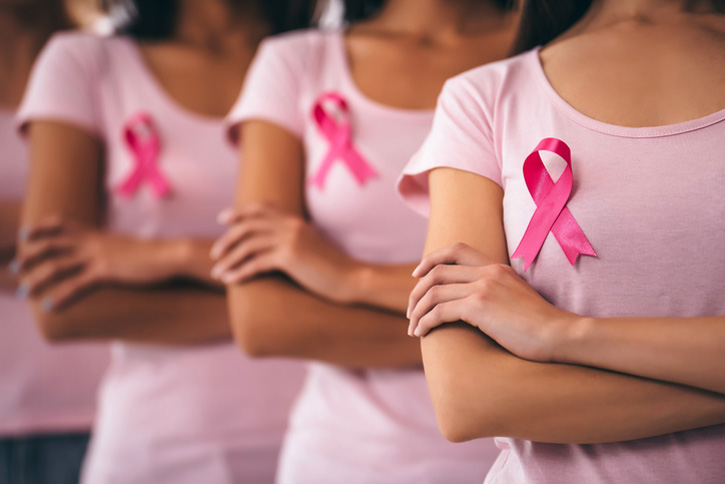Breast cancer is the #1 cause of cancer death in women. The average woman has a 1 in 8 chance of being diagnosed with breast cancer at some point in her life. The majority of breast cancers in the United States are diagnosed as a result of an abnormal screening study (~43%), while a significant number are brought to attention by self-exam (~40%). New technology is providing more screening options, creating more confusion than ever about which method is best.
My goal in writing this article is to turn that confusion into confidence by educating you about the most popular methods of breast cancer screening, so you can make an informed and educated decision!
As a naturopathic doctor that sees breast cancer patients regularly, I cannot stress the importance of regular mammography as a screening tool for breast cancer enough.
*Disclaimer: Always discuss your screening options with your licensed health care professional! They are there to help.
First, you should determine your risk of developing breast cancer. Knowing your overall risk of developing breast cancer is essential in deciding which screening method best fits your needs.
A helpful tool to evaluate your risk is the Gail Model. The Gail Model calculates an individual’s approximate risk of developing breast cancer before age 90 and risk of developing breast cancer within the next five years. The Gail Model is intended for women who have never had a diagnosis of breast cancer, and who do not have a strong family history of breast cancer. The Gail Model uses information such as you age, race, ethnicity, and personal and family medical history, to evaluate your risk of developing breast cancer.
Please know that the Gail Model does NOT estimate the risk of carrying a BRCA1 or BRCA2 gene mutation. Also, risk estimates for races or ethnicities other than Caucasian and Black may not be as accurate with the Gail Model.
The Gail Model is readily available at the National Cancer Institute website, and is easy to use.
Self Breast Exam
It has been suggested that average-risk women not perform self-breast exams. This suggestion is based on several studies that showed lack of benefit, and a higher rate of breast biopsy that showed benign disease.
However, performing a self-breast exam on a monthly basis is a great way to familiarize yourself with your breast tissue. Knowing what your breast(s) look and feel like on a regular basis can be helpful when deciding to call to your primary care provider to further investigate changes you may see or find.
For menstruating women, I recommend you perform your self-breast exam the week you finish menstruating, as hormonal shifts associated with menstruation can produce changes in the breast that may be confused with an abnormal finding.
What is it? During a self-breast exam, you will use a combination of visual examination in front of a mirror, and feeling you breast tissue with your fingertips to search for any abnormalities or changes. Common abnormal findings include lumps, dimpling of the skin, and retraction of the nipple(s).
When should I do it? Monthly, after menstruation, for women who are currently doing so.
Where is it done? A self-breast exam is done in the comfort of your own home. The exam is performed in front of the mirror, and laying down.
Why should I do it? Become familiar with your breasts, your breast tissue, so that you can readily and easily identify concerning changes.
How is it done? Since I can’t show you myself, please watch this video for a great example of how to perform a proper self-breast exam at home.
Mammography
Whether you are at average, moderate, or high risk of developing breast cancer, mammography is the best-studied and only imaging technique that has been shown to decrease mortality. I strongly encourage all women to get their mammogram according to their primary care providers recommendations not just because they work, but because they SAVE LIVES.
In a 2015 systematic review and a 2012 meta-analysis that each included multiple randomized trials that involved over 600,000 women from several countries, screening mammography was estimated to reduce the odds of dying of breast cancer by approximately 20 percent.
The average age women begin getting mammograms is age 40. Make sure to discuss getting a mammogram with your primary care provider when you are 40, if not before!
What is it? A mammogram is a picture of your breast taken with a safe, low-dose x-ray machine.
*The amount of radiation one is subjected to from a typical mammogram is .4 millisieverts (mSv). Compare that to the 3 mSv background radiation we are exposed to in our natural everyday surroundings on an annual basis. Getting a mammogram, then, is the equivalent of only 7 weeks of normal everyday life.
When should I do it? For average and moderate risk women, screening mammography is recommended every two years.
For high-risk women (those who have BRCA or other susceptibility genes, a history of chest radiation, or a calculated lifetime risk of developing breast cancer of greater than 20 percent), it is important both to emphasize the importance of mammography, generally with enhanced modalities (such as ultrasound, or contrast-enhanced breast MRI) and increased frequency (annual vs. biannual).
*Recommendations will vary according to age and organization. Always consult with your primary care provider about when and how often you should get a mammogram.
Where is it done? At a hospital, clinic, or breast imaging center. Most insurance plans cover the cost.
Why should I do it? To detect breast cancer early, therefore increasing your survival rate, and saving your life!
How is it done? Your breast will be placed on a flat plate called a paddle and compressed with a parallel paddle. This is done to spread out your breast tissue. An x-ray machine will produce a burst of x-ray that will pass through the breast to a detector on the opposite side. The detector captures the image on film or solid-state detector, which transmits electronic signals to a computer to form a digital image called a mammogram.
Thermography
First and foremost, thermography is a tool that should NOT replace regular mammograms. The evidence is clear that mammography is the best screening tool for early breast cancer detection. Although, thermography may be a useful as an additional screening tool to track changes in heat and vascular patterns of the breast(s) in between mammograms.
Thermography is a noninvasive, noncontact procedure that does not involve radiation or compression of the breast.
Thermography has been available for several decades, but there is no evidence to show that it’s a good screening tool to detect breast cancer early, or as a replacement for regular mammograms.
Providers of thermography note it does not detect cancer, rather it alerts to changes that may need further investigation, such as mammography. While thermography may show changes in heat and vascular features, it does not show how the breast itself has changed.
However, researchers are developing and testing new versions of thermography that someday may improve the test’s accuracy and usefulness.
What is it? Thermography uses an infrared camera that creates an image by converting heat energy that radiates from the body into a signal, which can then be viewed on a monitor and printed. The images produced are evaluated to detect heat patterns and blood flow in breast and body tissue. Thermography does not use radiation, and there is not contact with the body to produce images.
When is it done? Most women who choose a thermography scan in place of mammography will have a scan done according to mammogram recommendations; annually or every other year.
However, I DO NOT recommend thermography in place of mammogram. Rather, I recommend it as an additional screening tool option in between mammograms.
Where is it done? A privately owned clinic or wellness center. Insurance does not cover the cost.
Why should I do it? Most women choose thermography because they do not wish to subject themselves to radiation.
Again, I DO NOT recommend forgoing a mammogram.
How is it done? Thermography is preferably performed in the nude. Typically, you stand in front of the infared camera for about 10 minutes and then sit in a chair in 6-30 different positions depending on the screening that you choose. The whole procedure usually lasts between 10-30 minutes.
I hope you found this information useful! If you ever have any questions regarding breast cancer screening, make sure to reach out to your health care provider.

